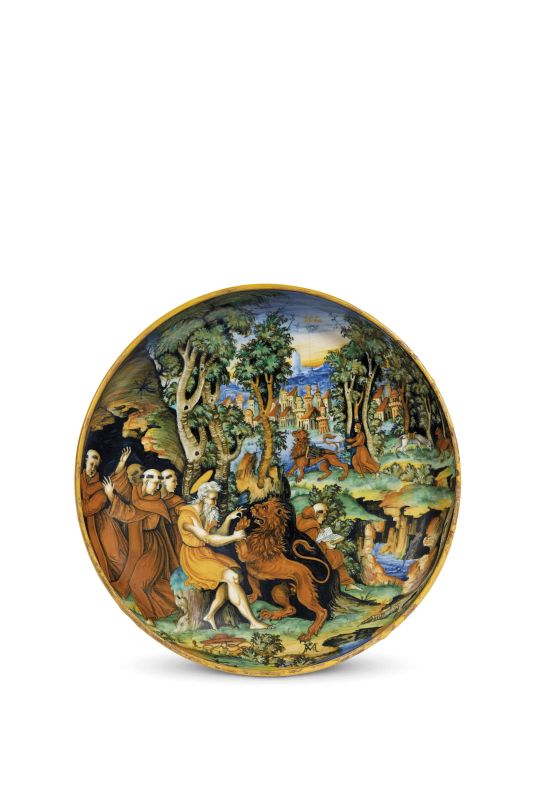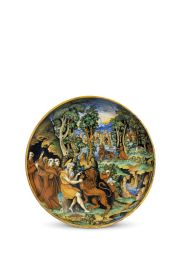A DISH URBINO, WORKSHOP OF GUIDO DURANTINO, SIGNED WITH THE MONOGRAM AM, F.S., FORMERLY THE WORKSHOP OF FRANCESCO DE SILVANO (?), 1542
Hgt. 6,2 cm; Ø 27 cm; Ø foot 13,8 cm
Majolica with polychrome decoration: yellow, yellow-orange, blue, dark blue, green, manganese brown and white.
Inscriptions:
On the front, beneath the lion’s paw: the monogram AM surmounted by an asterisk with the initials F.S.
On the back, in the center of the foot “1542 / Come San.ierronimo Cava. La / spina dalla zampa. al lione / Urbino” painted in blue.
Labels: on the back, printed label “Galleria Pesaro Milano/ 237”; stamped label “Ufficio Esportazione” with the number 10 written in black ink.
Provenance
Turin, collection of Marchese D’Azeglio;
Milan, collection of A. Chiesa;
Milan, Agosti e Mendoza Collection (Galleria Pesaro sale, 1936, lot 237);
Milan, collection of A. Rivolta;
Milan, Palazzo Ferrajoli (Sotheby’s sale, 4 December 1996, lot 721);
Milan, private collection
References
W. Chaffers, The Collector's Hand Book of Marks and Monograms on Pottery & Porcelain of the Renaissance and Modern Periods, London 1909 (second edition), p. 66;
L. De Mauri, L'amatore di maioliche e porcellane, Milan 1924 (third edition), p. 729;
G. Botta, Le collezioni Agosti e Mendoza, Galleria Pesaro, Milan December 1936, pl. XCIV, cat. 237;
A. Minghetti, Enciclopedia Biografica e Bibliografica Italiana. Ceramisti - Artisti, Botteghe, Simboli dal Medioevo al Novecento, 1939, pp. 386-387
A deep bowl with raised, straight rim, rounded and bordered in yellow, low ring-foot with slightly outward curved base and rounded edge. The decoration covering the entire surface is painted on a gray-white glaze with many inclusions, using bright colors and subtle retouches done with the tip of the paintbrush to emphasize the features and contours of the figures. The abundant use of dark colors emphasizes the shadows and some of the landscape details such as Saint Jerome’s cave, while facial features and musculature are highlighted with tin white which is also used in the same way on the landscape that is dominated by cold colors as opposed to the warm tones of the figures.
The scene refers to a legendary episode from the life of Saint Jerome as told by Jacopo da Varazze in the Golden Legend (Legenda Aurea) (1), but depicted here according to another version. On the plate, the lion comes to Jerome in his cave and it is the saint himself, who removes the thorn from the animal’s paw and treats the wound; the miracle is accompanied by the apparition of a cherub surrounded by five stars in the sky. Near Saint Jerome’s feet is a cardinal’s hat, and in the foreground, to his left, are the frightened brothers who are fleeing the scene. They are depicted according to the iconographic traditions we see in famous Renaissance paintings such as the Scenes from the Life of Saint Jerome by Vittore Carpaccio (2) or Benozzo Gozzoli’s 1452 frescoes of the Crucifixion with Saints and Scenes from the Life of Saint Jerome in the chapel of Saint Jerome in the church of San Francesco at Montefalco (3). The iconography of Saint Jerome in the center of the scene is more common and can be seen in other period works such as the woodcut of Saint Jerome Extracting a Thorn from the Lion’s Paw by Giovanni Battista Palumba (c. 1500-1516) (4). In the background, a city with towers and two more episodes from the legend: the lion guarding the donkey, and the lion’s punishment working as a pack animal.
The back is not decorated, merely inscribed: “1542 / Come San.ierronimo Cava. La / spina dalla zampa. Al lione / Urbino.
This iconography of Saint Jerome (5) fits in with the most popular view of the saint. However, in reality he is linked to the spread of Origen’s exegeses in the West, the increased number of men turning to the ascetic life during the second half of the fourth century and the first twenty years of the fifth, and his Latin translation of the Bible which is known as the Vulgate version.
The plate shown here has a complex history. The earliest information we have found dates to 1893 (6): a description related to the monogram F and S surmounted by an asterisk, beneath the lion’s paw. The monogram is attributed to pottery from Urbino and the plate is described as having belonged to the collection of Marchese D’Azeglio in Turin. A few years later, the same monogram was described in De Mauri’s compendium (7), where it was shown with a similar symbol, with a dating beneath, and both were ascribed to antique majolica wares from Urbino. The plate turned up in the Agosti e Mendoza collections, and was sold at the Galleria Pesaro in Milan in 1936 (8). The Galleria Pesaro sale catalogue gave the provenance as the collection of A. Chiesa, with an attribution to Francesco Xanto Avelli on the basis of the monogram that was related to the large plate depicting the Attack on the City of Goletta by the Fleet of Charles V, which the artist from Rovigo dated 1541 and signed “X”, with the inscription “In Urbino nella botteg. di Francesco de Silvano” (9). Aurelio Minghetti published the plate three years later (10), describing it as “majolica plate [by] Francesco Silvano )?) Urbino 1542” (piatto di maiolica Francesco Silvano (?) Urbino 1542) in the collection of A. Rivolta in Milan. The author hypothesized that the initials stood for Francesco Silvano, and associated it with the above-mentioned plate portraying the Attack on the City of Goletta. Nearly sixty years later, the plate was once again on the market, this time in the 1996 Sotheby’s (Milan) sale of the Palazzo Ferrajoli collections (11) and with an attribution to Guido Fontana.
Timothy Wilson had advanced the hypothesis (12) that some of the unsigned pieces dated 1542 were the fruit of cooperation between Francesco Xanto Avelli and other painters at the twilight of the famous ceramicist’s career. Wilson suggested that Francesco di Silvano may have been Francesco Durantino, who was still active in 1542 either in Guido Durantino’s or his own workshop, to then move to Guido da Merlino’s studio the following year. Therefore, could the Francesco Durantino have been the potter Francesco de Berardino Silvano with whom Xanto worked in 1541? (13) Francesco’s father was Bernardino (14), and the “Berardino di Battista Gnagni di S. San Donato” in the 1514 registry in Casteldurante could be the same person. The first document mentioning Francesco was written in Guido’s Urbino workshop on 18 December 1537 (15).
Stylistic comparisons with pieces from Durantino’s workshop in Urbino – such as the dimensions of the plate, the landscape with its subtly defined grasses, the twisted trees, and a northern-type city, as well as the carefully depicted figures and the palette do not rule out the possibility of cooperation on the part of a painter who was trying to make a name for himself by adding his own initials – a highly uncommon practice at the time, and seen only in some rare cases.
There is similarity between our plate and others with high decorative value, such as the one with Noli me tangere, formerly in the Otto Beit collection, that was recently published by Paola Sani. In both items we can see the same expressive power in the figures, similar colors, especially the green grasses, the details of the background landscape, the depiction of scenes on more than one plane, as well as the fence in the foreground along with other defining features that could suggest an attribution to the young Orazio Fontana who was still active in his father’s workshop.
1) Jacopo da Varazze, also called Jacopo da Varagine, recounted the lives of saints in the Legenda Aurea, that he worked on from 1260 to his death in 1296. In chapter 146 dedicated to the life of Saint Jerome, he narrates the episode in which a lion limped to the monastery where he lived. As his brothers fled in fright, Jerome approached the wounded animal and ordered his brothers to wash its paws and care for him. Once he had healed, the lion stayed at the monastery and the brothers ordered him to guard their donkey. One day, the lion fell asleep while the donkey was grazing, and it was stolen by some passing merchants. When the lion returned to the monastery alone, he was accused of having eaten the donkey and as punishment was made to do the donkey’s work. One day the lion encountered the merchant caravan and recognized the donkey. After having frightened off the merchants, he led the donkey and the camels laden with goods back to the monastery. When the merchants arrived at the monastery to reclaim their goods, Saint Jerome forgave them and acknowledged that the lion was innocent.
2) Carpaccio’s Scenes from the Life of Saint Jerome are in the Scuola Dalmata di San Giorgio degli Schiavoni in Venice.
3) The Montefalco frescoes, that are datable to 1452, were his first works as a master. They were probably commissioned by the local nobleman Girolamo di Ser Giovanni Battista de Filippis. Unfortunately most of the frescoes with the Scenes from the Life of Saint Jerome have been lost; however it is likely that they were reproduced in one or more, as yet unidentified, contemporary engravings.
4) The Illustrated Bartsch, XIII, p. 249 n. 1. This print is considered the masterpiece woodcut by the engraver identified as G.B. Palumba.
5) Saint Jerome is portrayed in three distinct ways: as a penitent clothed in skins or rags, kneeling before a crucifix and holding a stone to beat his breast, with an hourglass and skull nearby symbolizing passing of time that leads to death; as a man of learning, sitting in his study, either writing or reading, with books, pen and other tools of knowledge; as a Doctor of the Church, standing, wearing cardinal’s robes even though the office of cardinal did not exist at the time, but, the symbols are probably in recognition of the fact that he worked for the pope.
6) W. Chaffers, The Collector's Hand Book of Marks and Monograms on Pottery & Porcelain of the Renaissance and Modern Periods, London 1893
7) L. De Mauri, L'amatore di maioliche e porcellane, Milan 1899
8) G. Botta, Le collezioni Agosti e Mendoza, Galleria Pesaro, Milan December 1936, pl. XCIV, cat. 237
9) See J.V.G. Mallet, “La biografia di Francesco Xanto Avelli alla luce dei suoi sonetti”, in Faenza 70, and J.V.G. Mallet, with contributions by G. Hendel and E.P. Sani, Xanto. Pottery-painter, Poet, Man of the Italian Renaissance, exh. catalogue, Wallace Collection, London 2007
10) A. Minghetti ,Enciclopedia Biografica e Bibliografica Italiana" il volume "Ceramisti - Artisti, Botteghe, Simboli dal Medioevo al Novecento" 1939, pp. 386-387
11) Sotheby’s, Importanti Mobili, Dipinti, Ceramiche, Argenti e Sculture, Collezioni d’arte da Palazzo Ferrajoli, Milan December 1996, lot 721
12) T. Wilson, Italian Maiolica of the Renaissance, Milan 1996, n. 93
13) T. Wilson, Italian Maiolica of the Renaissance, Milano 1996, n. 110 note 4, revised after 1998, when the attribution hypothesis seems to have fallen out of favor.
14) S. Balzani, M. Regni, Vasai e pittori a Casteldurante nei primi due decenni del secolo XVI, Urbino 2004, p. 68
15) T. Wilson, “The Maiolica-Painter Francesco Durantino: Mobility and Collaboration in Urbino “istoriato”” in S. Glaser, Italienische Fayencen der Renaissance. Ihre Spurenininternationalen Museumssammlungen, Nuremberg 2004, pp. 111-144










